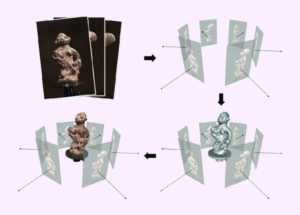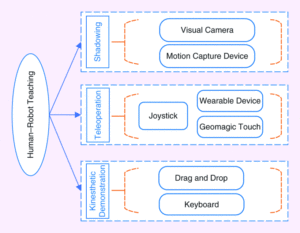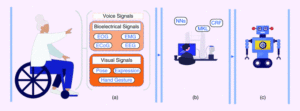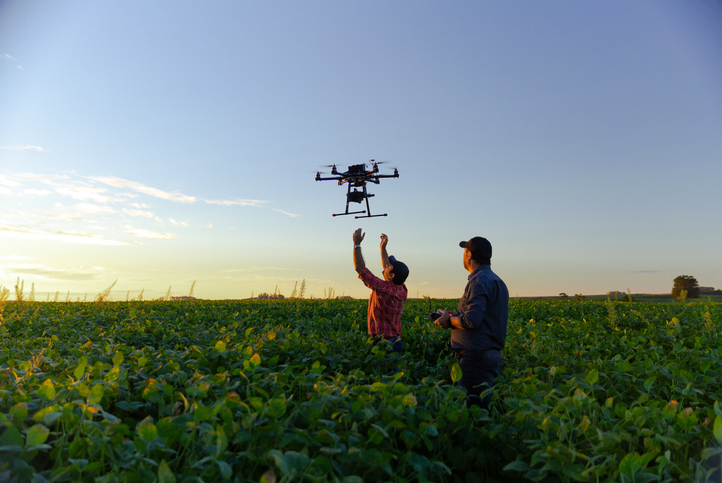Human-robot collaboration has always been a point of interest in the robot community, gaining traction as technology evolves. Human-robot collaboration promotes the idea that robots can become a part of human life in hospitals, restaurants, and homes. Effective human-robot collaboration releases humans from repetitive, dangerous tasks so they can devote energy to more sophisticated tasks.
Population aging is inevitable, leading to an urgent need for service robots. An article in IEEE Systems, Man, and Cybernetics Magazine reviews the literature on environmental perception, compliance control, and intention recognition for elderly service robots. The researchers present several aspects focusing on processing multimodal signals and challenges that must be overcome to reach interactive performance comparable to humans.
Finding the Right Perception System
For elderly service robots, physical collaboration focuses on equipping robots with the ability to meet the needs of older adults in real life. According to the researchers, in order to adapt to the dynamic surroundings and choose a suitable policy for the task—service robots should be able to analyze the data coming from the environment, develop strategies, and plan motion. The rapid development of electronic hardware technology and artificial intelligence (AI) provides a strong guarantee for realizing these prospects in robotics.
The main goal is to acquire information about the surrounding environment and extract the significant features from noise to understand the environment through robot sensors. Supported by the accurate perception of the surrounding environment, elderly service robots can better assist humans by cleaning the house, cooking, and feeding. Locating the proper object from images has always been the most challenging problem in computer vision. Based on the research, the authors suggest combining techniques from 2D and 3D technologies to solve this problem.

Multiperspective 3D reconstruction
Compliance Control: Human-Robot Teaching
According to the article, giving robots the ability to work across tasks and environments, making the human-robot interaction process smooth and natural—is a significant problem in the robot community. Limited by technology, designers cannot yet imagine all situations and endow robots with corresponding tips and skills. To deal with this problem, the researchers suggest looking at the theory of learning from demonstration (LfD). The core idea is to simplify the functional deployment of robots, where robots can quickly master new skills through simple human demonstration.

The methods of human-robot teaching.
To construct effective human-robot collaboration, elderly service robots need knowledge transfer and autonomous learning abilities. Noted in the article, research in robotics has focused on combining various types of AI technology to realize some manipulation tasks (i.e., grasping, handing over, and opening the door). Machine learning trends promote LfD learning schemes or reinforcement learning (RL) so the robot can learn more complex skills. In addition to RL, other aspects of machine learning are also used in robot skill learning. With the help of various open-source large-scale datasets, service robots can be trained robots based on the elderly care context and personal preferences through simulation.
Sensing Intention
To achieve better human-robot interaction, service robots should analyze multimodal information from the subjects to realize intention recognition. As noted in the article, multimodal information comes from different local features:
- Bioelectricity Signal: These come from the human body and can be divided into biological electrical and biomechanical signals.
- Visual Signal: Service robots use camera sensors to identify unique feature descriptors and extract target information from the image (which includes posture, facial expression, and hand gesture recognition).
- Audio Signal: Language is the most common way to identify an individual’s intentions, where adults communicate their intentions directly to the robot through voice communication.

The process of intention analysis using multiple sensing signals.
Different sensing methods can complement one another and improve the performance of robots effectively, especially in complex environments. Service robots should take multichannel sensor information as input to meet the various aspects of users’ needs and improve decision-making.
Future Challenges
The article outlines several challenges for maintaining stable communication and cooperation between humans and robots:
- Experimental Design: Simulation can significantly help researchers when developing robotic applications, and benchmarking approaches for elderly service robots should consider the subjective feedback of the subject and the quality of task execution.
- Trust Issues: Service providers should consider the subject’s preferences and privacy issues. In addition, robots must ensure objects' safety when performing tasks.
- Learning Capability: Finding a unified robot platform is critical for the real-time response of robots assigned to many possible complex tasks.
To conclude, the authors note that only when the robot correctly recognizes the human intention and completes the corresponding task efficiently can human-robot collaboration be considered successful.
Interested in learning more about Robotics? IEEE offers continuing education with the IEEE eLearning Library to smartly implement digital tools into your organization.
Interested in acquiring full-text access to this collection for your entire organization? Request a free demo and trial subscription for your organization.





